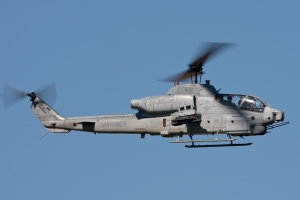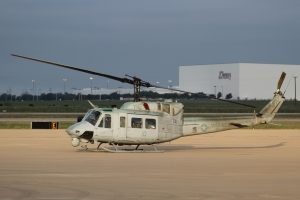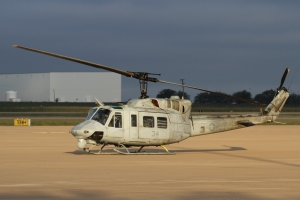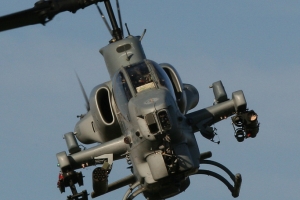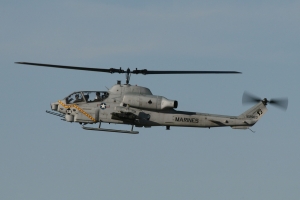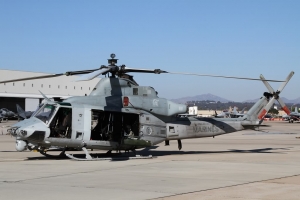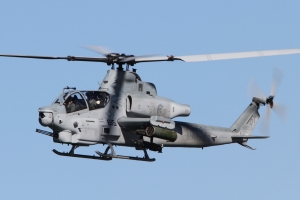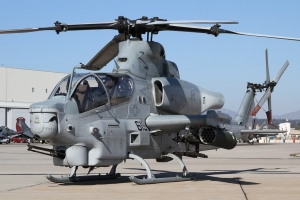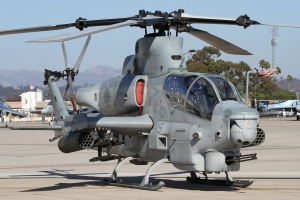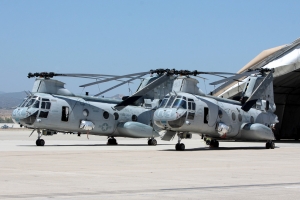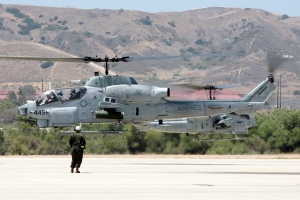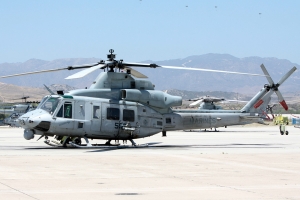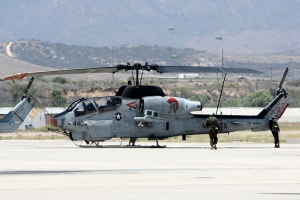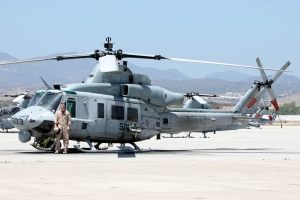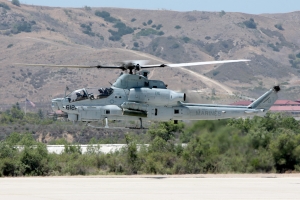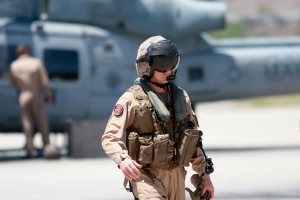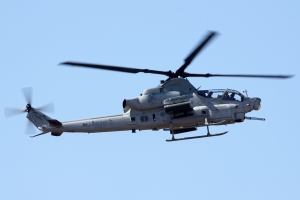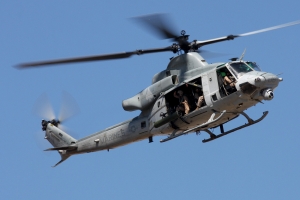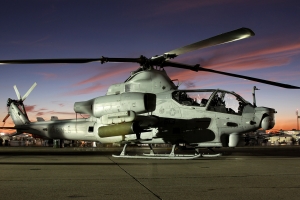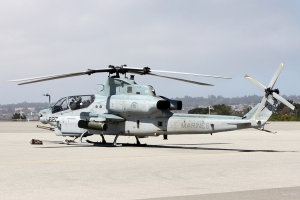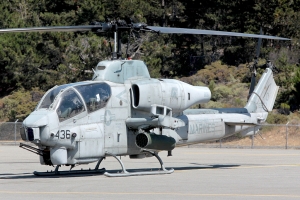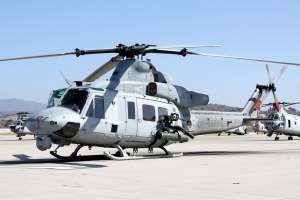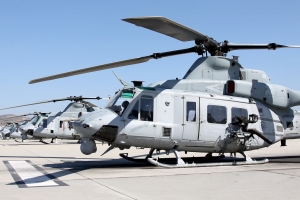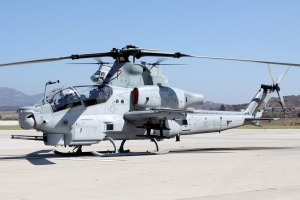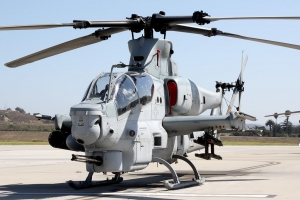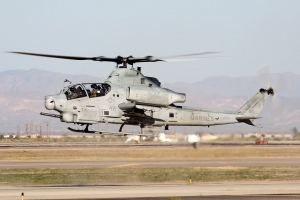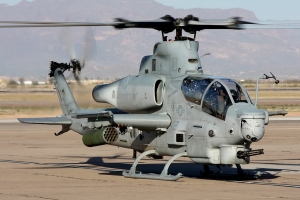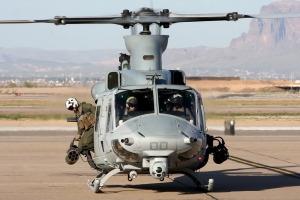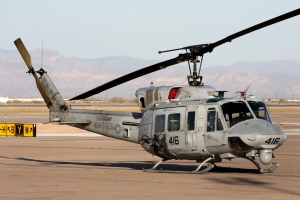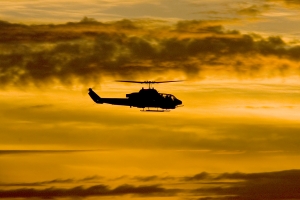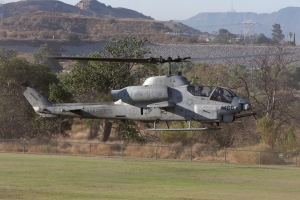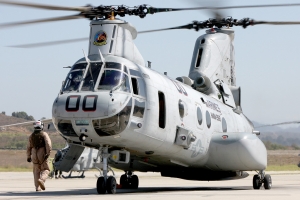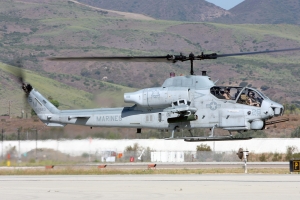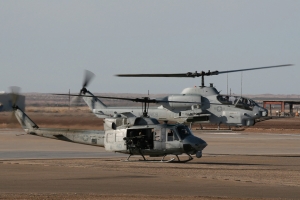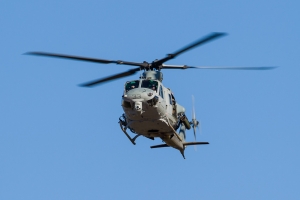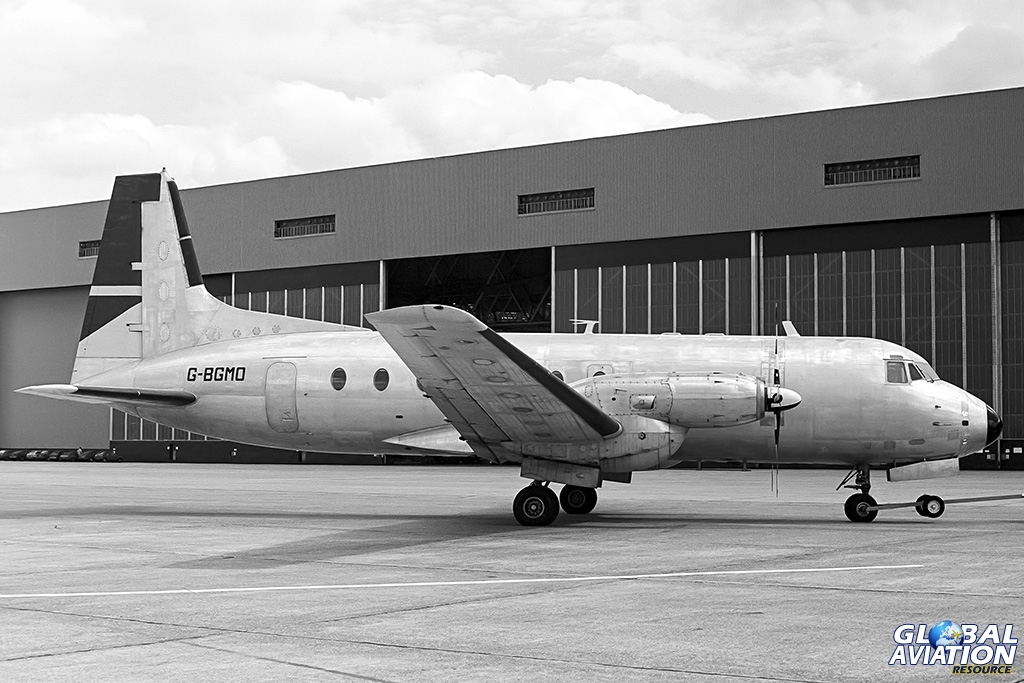As the USMC’s only light attack helicopter training squadron, HMLAT-303 ‘Atlas’ is responsible for training all UH-1Y, AH-1W and AH-1Z aircrew. Paul Dunn visited MCAS Camp Pendleton to learn more about these exciting types, and talk to some of the people that operate them.

The Bell AH-1Z Viper, The USMC’s newest attack helicopter © Paul Dunn – www.globalaviationresource.com
US Marine Corps Aviation is currently in an exciting period of transition, with new types arriving in virtually all the Corps’ unit categories. Replacement of the CH-46 Sea Knight with the MV-22B Osprey is proceeding apace, with only a handful of squadrons left operating the ‘Phrog’. The first operational F-35 Lightning II squadron (VMFA-121) recently stood up at MCAS Yuma, and the CH-53K programme to replace the CH-53E Super Stallion is close to a first flight.
On the face of it, the transition within the light attack helicopter community has been more of an evolution than a revolution, with improved versions of well-established types entering service. In reality the UH-1Y and AH-1Z represent a huge improvement in performance and capability for the Corps and promise to vastly improve the ability of the HMLA squadrons to support their fellow Marines on the ground.
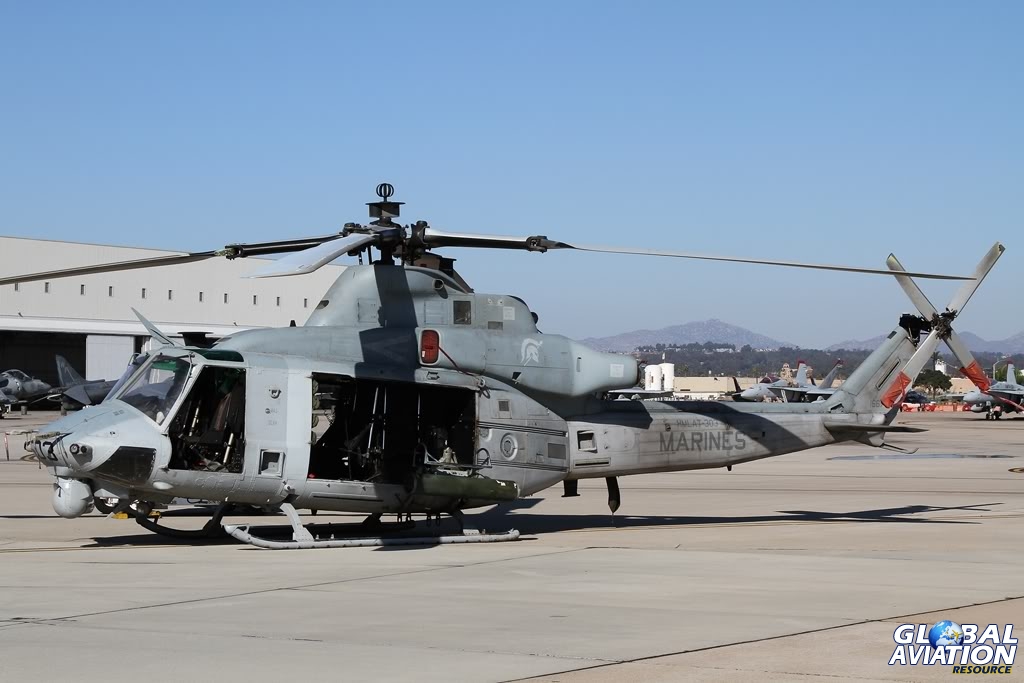
The Bell UH-1Y Venom © Chris Wood – globalaviationresource.com
The Marine Corps’ association with the Bell H-1 family goes back almost 50 years. In 1962, the Corps selected the UH-1 to replace its fleet of Kaman OH-43D Huskie helicopters and Cessna O-1 aircraft. The first aircraft delivered were based on the Army’s UH-1B and designated UH-1E.
Later orders were for the twin-engined UH-1N version, which arrived in the early 1970s and served in large numbers. It was the subject of successive upgrade packages during its career.

The UH-1N has now been almost completely replaced by the UH-1Y © Paul Dunn – globalaviationresource.com
During the mid-1960s, Bell developed the AH-1G for the US Army. This attack helicopter was based on the UH-1, and shared many components including engine, transmission and rotor system. The Marine Corps was very interested in the new aircraft but requested a twin-engined version for added safety in over-water operations. The resulting design was designated the AH-1J SeaCobra.
In the 1970s, an upgraded version of the AH-1, the AH-1T, was delivered. This version featured more powerful engines, better avionics and improved armaments. A further upgraded version, the AH-1W Super Cobra, appeared in the 1980s, with the fleet being made up of 179 new build aircraft and 43 upgraded AH-1Ts.
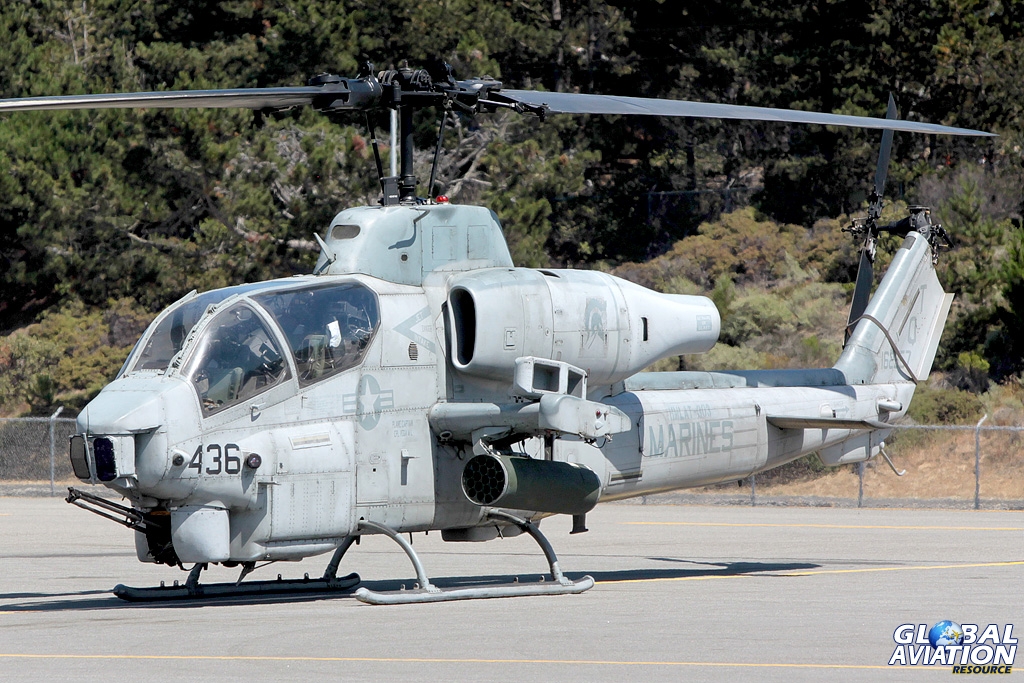
The older AH-1W Supercobra will remain in service for some years to come © Paul Dunn – www.globalaviationresource.com
By the 1980s, the AH-1 and UH-1 were operating alongside each other in the newly designated Marine Light Attack Helicopter Squadrons (HMLA), and this combination went on to serve in all of the subsequent Marine Corps engagements, including Operation Desert Storm and perhaps most notably in Operations Enduring Freedom and Iraqi Freedom, as part of the global war on terror.
Prior to the commencement of operations in Afghanistan and Iraq, the USMC identified a need to replace its fleet of UH-1s and AH-1s with improved types. The upgrade programme was officially launched in 1996, with the new types being designated UH-1Y and AH-1Z. Both were originally planned to be produced in part by upgrading existing UH-1N and AH-1W airframes; it was later decided that it would not be feasible to release enough UH-1Ns from service to be upgraded, so the UH-1Ys were instead ordered as new built airframes.
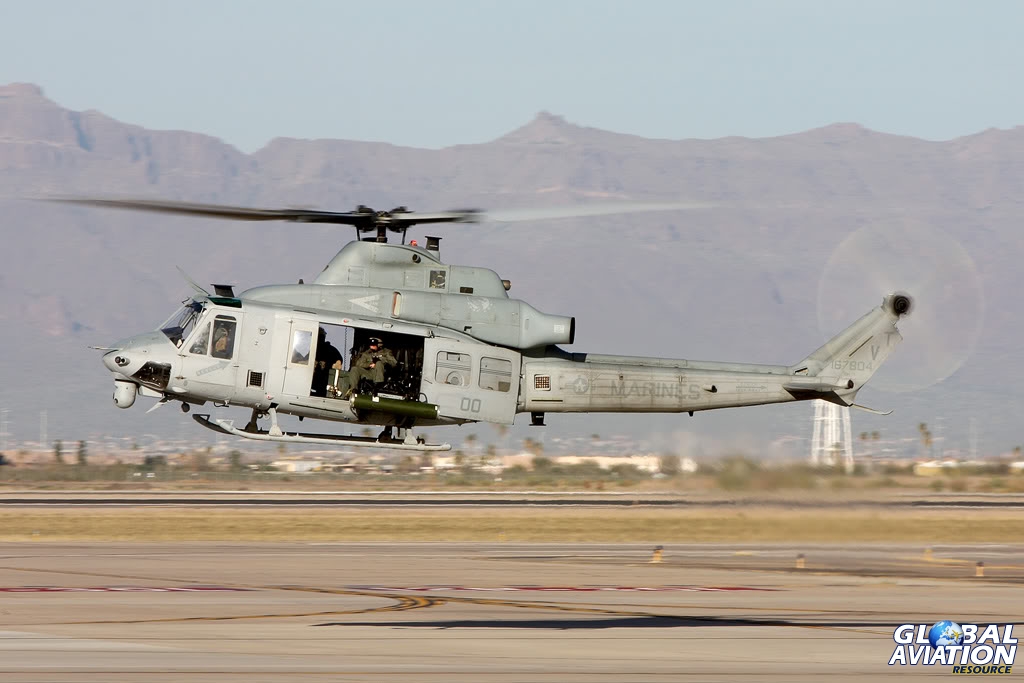
UH-1Y from HMLA-367 ‘Scarface’. Once part of MAG-39 at MCAS Camp Pendleton, the squadron has now moved to Hawaii and MAG-24 © Paul Dunn – www.globalaviationresource.com
The first UH-1Ys, officially named the Venom, (but also known to its crews as the Yankee, or indeed simply the Huey), were declared operational in 2008, and since then it has rapidly replaced the UH-1N in most of the fleet squadrons, with the older type serving only in small numbers in the hands of the reserve squadrons such as HMLA-773.

Reserve unit HMLA-773 is the final operator of the UH-1N © Chris Wood – globalaviationresource.com
The AH-1Z entered testing at the same time as the UH-1Y and was declared operational in September 2010. It has been officially named the Viper, but like the UH-1Y, it is more commonly known as the Zulu to those who fly it.
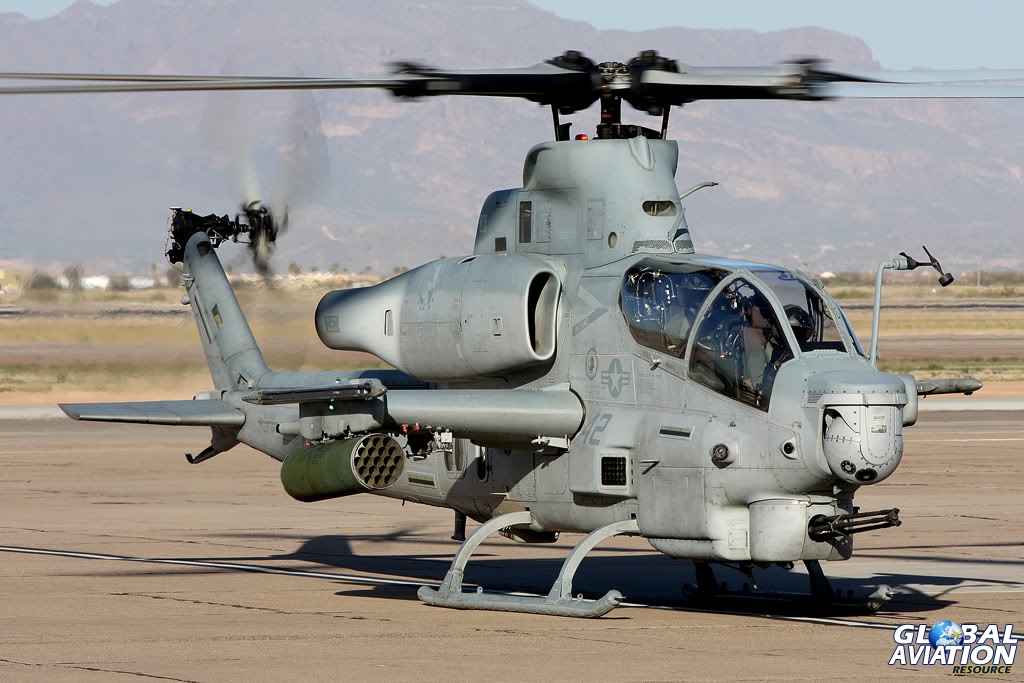
© Paul Dunn – www.globalaviationresource.com
Light attack squadrons are assigned to both East Coast (2nd Marine Aircraft Wing) and West Coast (3rd MAW) units, and a single squadron forms part of the 4th MAW, based at MCAS Kaneohe Bay, Hawaii. However, all crews destined for the HMLA units undergo training at MCAS Camp Pendleton, California.
The airfield at Camp Pendleton is home to Marine Aircraft Group 39 (MAG-39), a close air support and assault support unit composed of eight flying squadrons; five HMLA units plus three HMM (Marine Medium Helicopter) squadrons. The HMM units (HMM-268, HMM-364 and HMMT-164) represent the last bastion of the CH-46E Sea Knight and will in due course re-equip with the MV-22B Osprey.

MAG-39: HMMT-164 ‘Knightriders’, training unit for the CH-46E © Paul Dunn – www.globalaviationresource.com

MAG-39: HMM-268 ‘Red Dragons’ operate the CH-46E © Paul Dunn – www.globalaviationresource.com
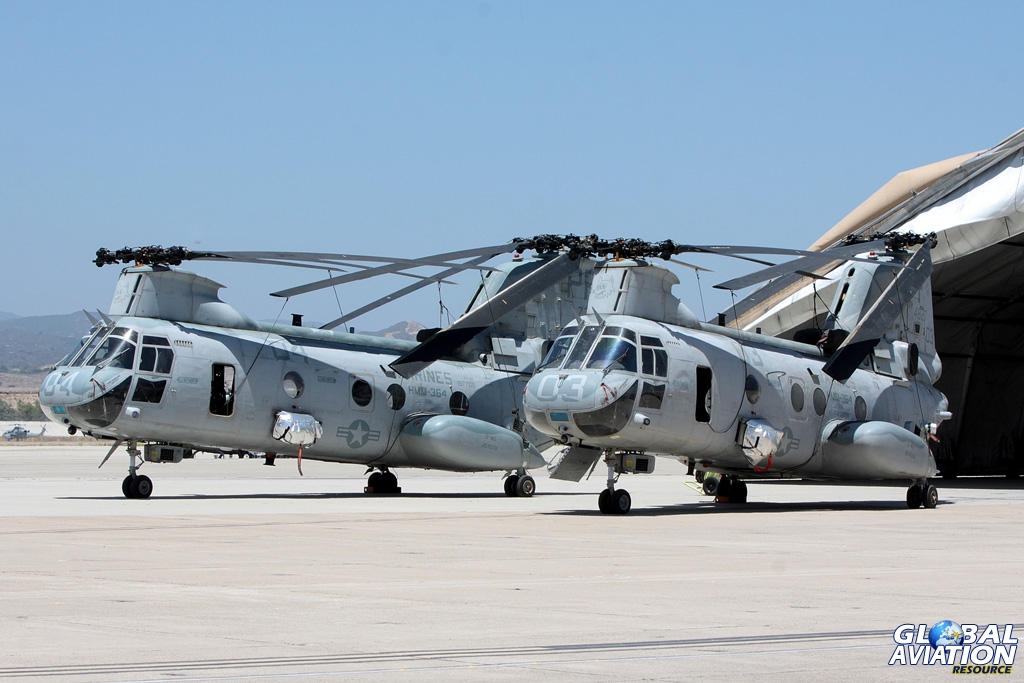
MAG-39: HMM-364 ‘Purple Foxes’ operates the CH-46E © Paul Dunn – www.globalaviationresource.com
The light attack squadrons include HMLAT-303 ‘Atlas’, which is currently responsible for training crews for three platforms; the UH-1Y, AH-1W and AH-1Z. Although the Zulu has entered service, there are still considerable numbers of Whiskeys in use so the unit expects to continue training pilots to fly it for some years to come. In addition to training pilots, 303 is also responsible for training crew chiefs destined for the UH-1Y. The remaining light attack squadrons are comprised of HMLA-169, HMLA-267, HMLA-369 and HMLA-469.
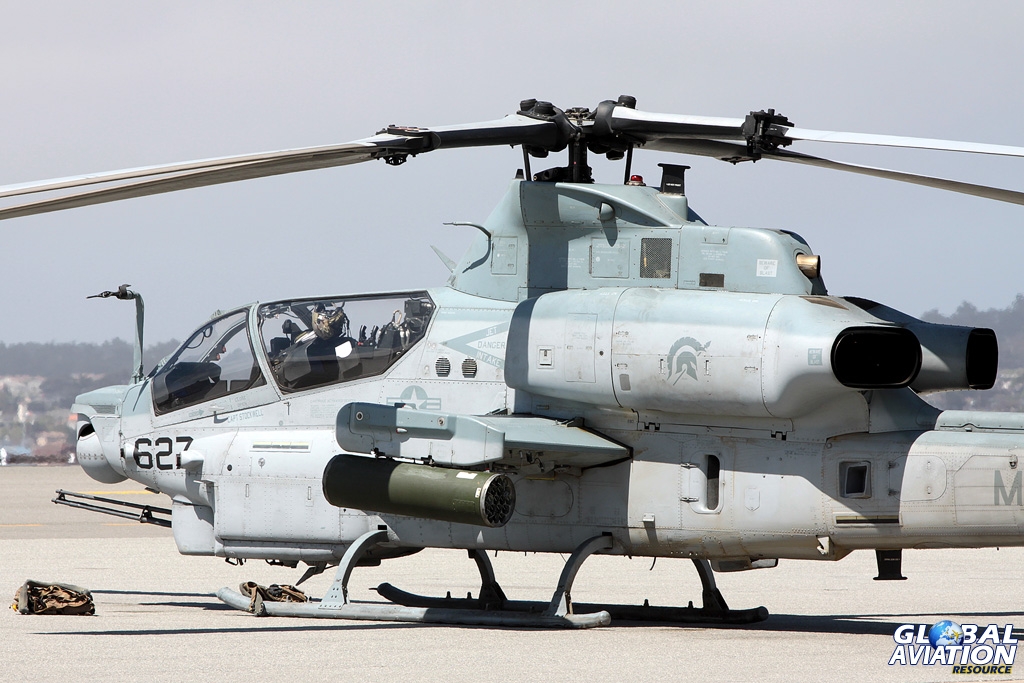
MAG-39: HMLAT-303 ‘Atlas’, training unit for the UH-1Y, AH-1W and AH-1Z © Paul Dunn – www.globalaviationresource.com

MAG-39: HMLA-169 ‘Vipers’, operate the UH-1Y and AH-1 © Paul Dunn – www.globalaviationresource.com

MAG-39: HMLA-267 ‘Stingers’ operate the UH-1Y and AH-1 © Paul Dunn – www.globalaviationresource.com

MAG-39: HMLA-369 ‘Gunfighters’ operate the UH-1Y and AH-1 © Paul Dunn – www.globalaviationresource.com

MAG-39: HMLA-469 ‘Vengeance’ operate the UH-1Y and AH-1 © Paul Filmer – www.globalaviationresource.com
GAM/GAR was able to spend time with a panel of instructors from 303, all of whom bring plenty of knowledge and experience to their role. Captain Bret Morriss is a UH-1Y pilot instructor. In common with many of the instructors on the squadron who teach the newer types, he also has experience of flying the previous generation of helicopters, in this case the UH-1N.
His colleague, Capt Scott Armstrong, is another pilot instructor assigned to HMLAT-303. He teaches students to fly the AH-1Z; like Capt Morriss, he also has experience on an older-generation type, in his case the AH-1W.
Representing the other component of the UH-1 crew, SSgt Zach Francis is a crew chief instructor, again with experience on both the Yankee and November versions of the UH-1.
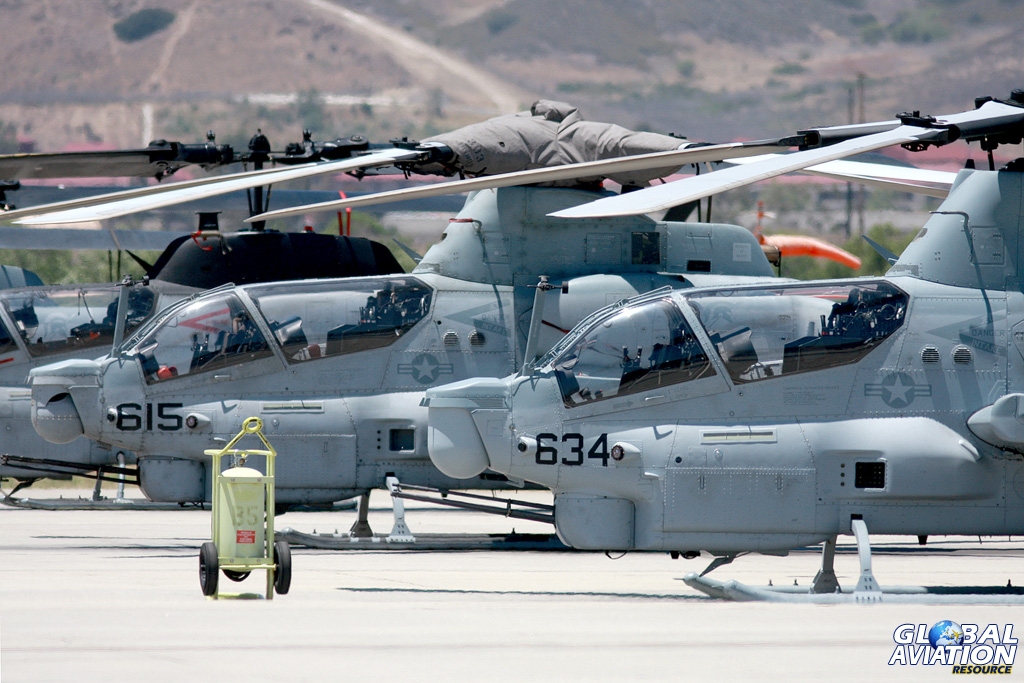
AH-1Zs on the HMLAT-303 flightline at MCAS Camp Pendleton © Paul Dunn – www.globalaviationresource.com
Together they represent a cross section of the team on HMLAT-303, who are responsible for training what is predominantly an inexperienced group of students, as Capt Morriss relates.
“The majority of our pilots are straight from flight school, they’re what we call our RACs, our Replacement Air Crew. They have minimal experience, maybe 200 hours. Their experience is pretty basic and they’ve never flown a Huey or Cobra before, only much smaller aircraft.
“The basis of what we teach them here is how to operate the aircraft safely and fly it from A to B safely. We don’t teach them a whole lot about tactics and weapons stuff. During the course, both the Cobra and the Huey have two shoots, but it’s not a lot of tactical, it’s more the basics of how the helicopter operates.”
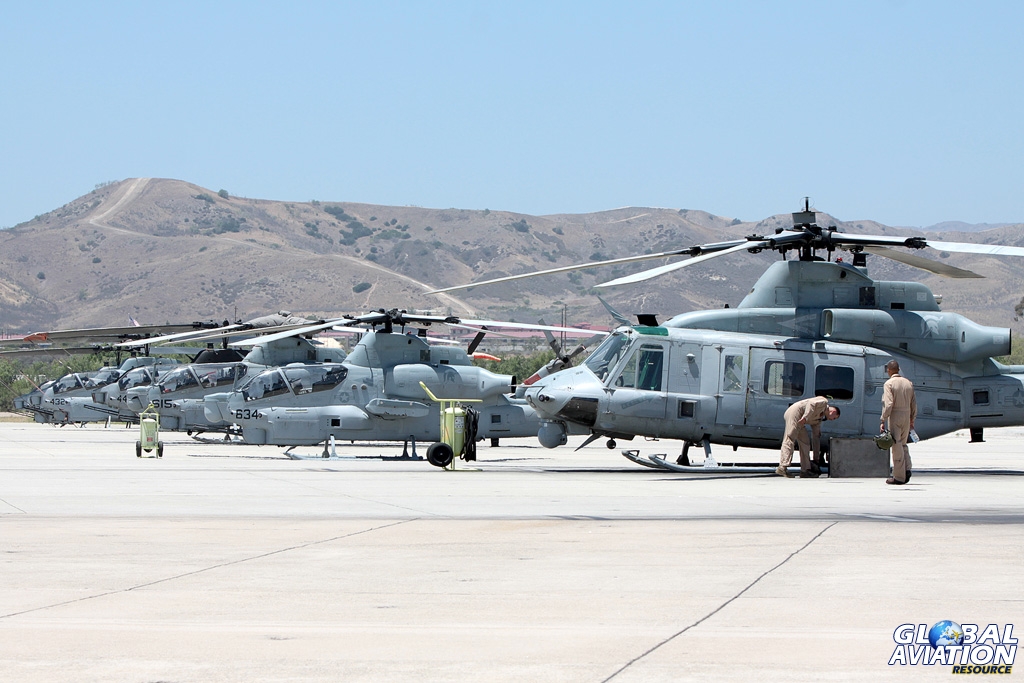
All three types operated by HMLAT-303 are visible in this lineup © Paul Dunn – www.globalaviationresource.com
The RACs have previously received their basic training as part of the US Navy’s training structure, so arrival at HMLAT-303 represents their first taste of a Marine Corps squadron.
“It’s kind of a transition. I wouldn’t say that we at 303 are a typical Marine Corps squadron; we are still a training squadron, but we are much more Marine Corps than the Navy squadron that they came from.”

© Paul Dunn – www.globalaviationresource.com
This transition forms part of the students’ initial training package on arrival at 303, as Capt Armstrong describes.
“The first two weeks they’re here, we put them through what we call Light Attack University. We give them academics for the systems of the helicopter, which is actually taught by the maintainers and crew chiefs as they are the subject matter experts.
“That first two weeks sets them up, gets them back into the Marine Corps, and reminds them who they are: Marine Corps officers. It also reminds them what that they are here to do, to learn the helicopter and the systems before we get them out to the fleet squadron, where they get the full tactical package.”
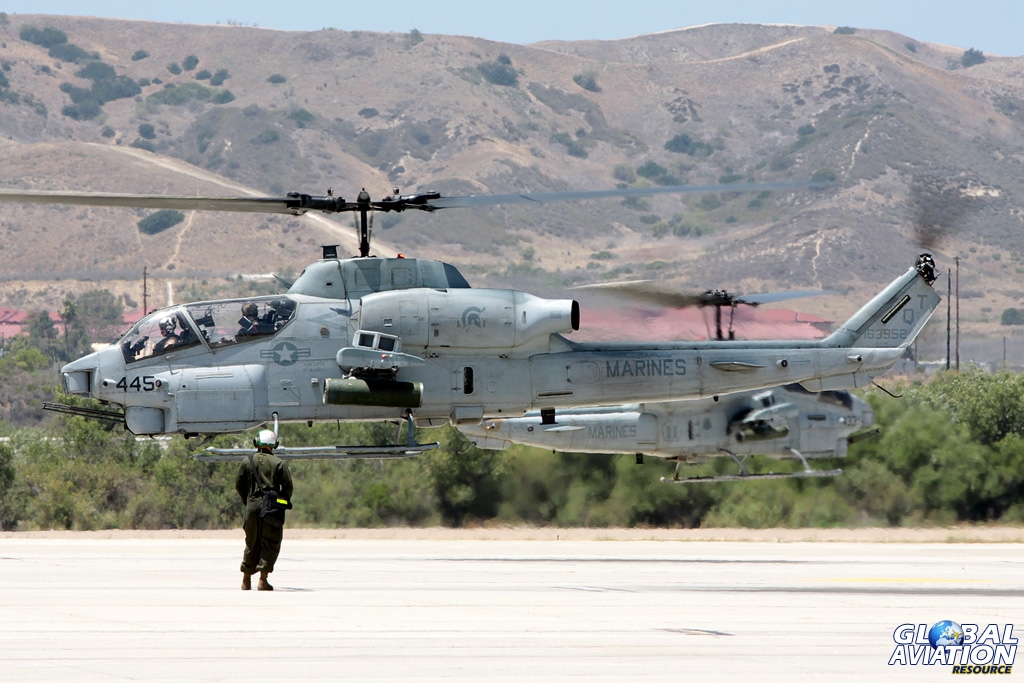
© Paul Dunn – www.globalaviationresource.com
As with all professional aviation, both military and civilian, teamwork is vital and CRM is a concept which the students are already very familiar with. It is the job of Capt Morriss and his colleagues to build on that basic knowledge.
“It’s introduced at flight school. For us, CRM covers everything from working with your crew, (ie two pilots working together and working with a crew chief), extending to the section, if you have a Cobra and a Huey, or two Hueys working together, and also using other assets like ATC and base who can help you solve problems. That’s all part of the CRM process, and it’s taught from day one of naval aviation. Here we just teach them how it applies to the new aircraft that they’re flying now and get them starting to think in a tactical sense too.

© Paul Filmer – www.globalaviationresource.com
“The other students we teach are the crew chief students. There’s a lot less experience with those guys, most of the time they’ve never flown before they get here.”
As a crew chief instructor SSgt Francis is responsible for taking young Marines, fresh from basic training, and introducing them to the unique responsibilities that come with being a part of the team operating an advanced helicopter.
“They’re really raw; they come here with zero flight hours, so for them it’s their first time stepping in a helicopter.”
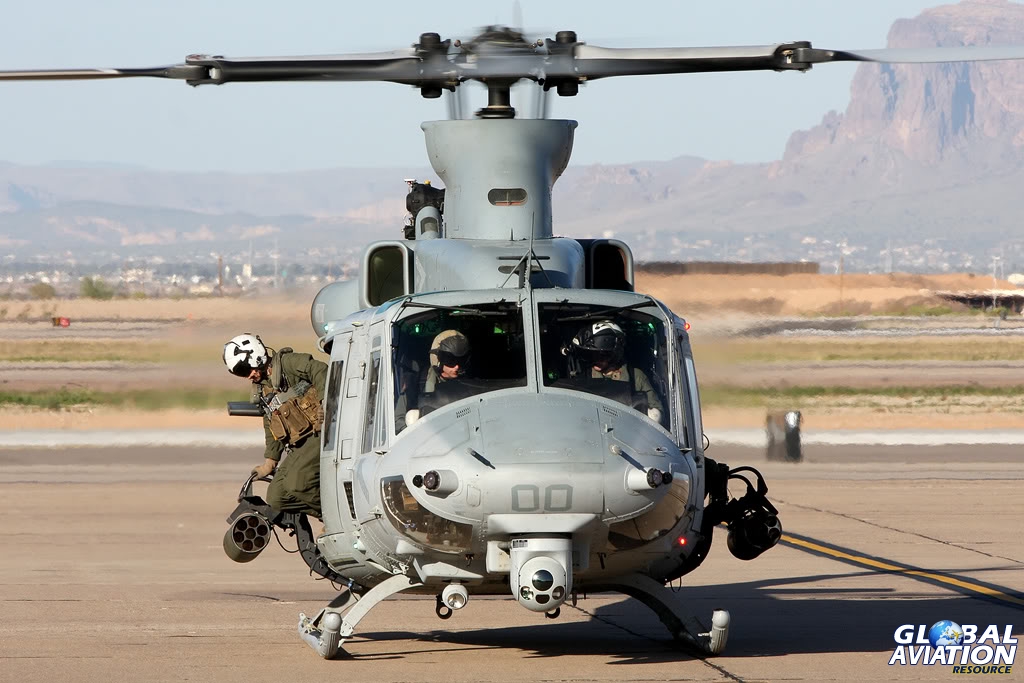
The crew chief is the first out of the aircraft as this UH-1Y touches down © Paul Dunn – www.globalaviationresource.com
These inexperienced crew chief students are teamed up with the brand new pilots from day one of the flying training.
“Most of the time it’s one RAC and one instructor pilot in the front, and in the back, one instructor CC and normally two students, whereas when you’re deployed it’s going to be two pilots and two crew chiefs.”
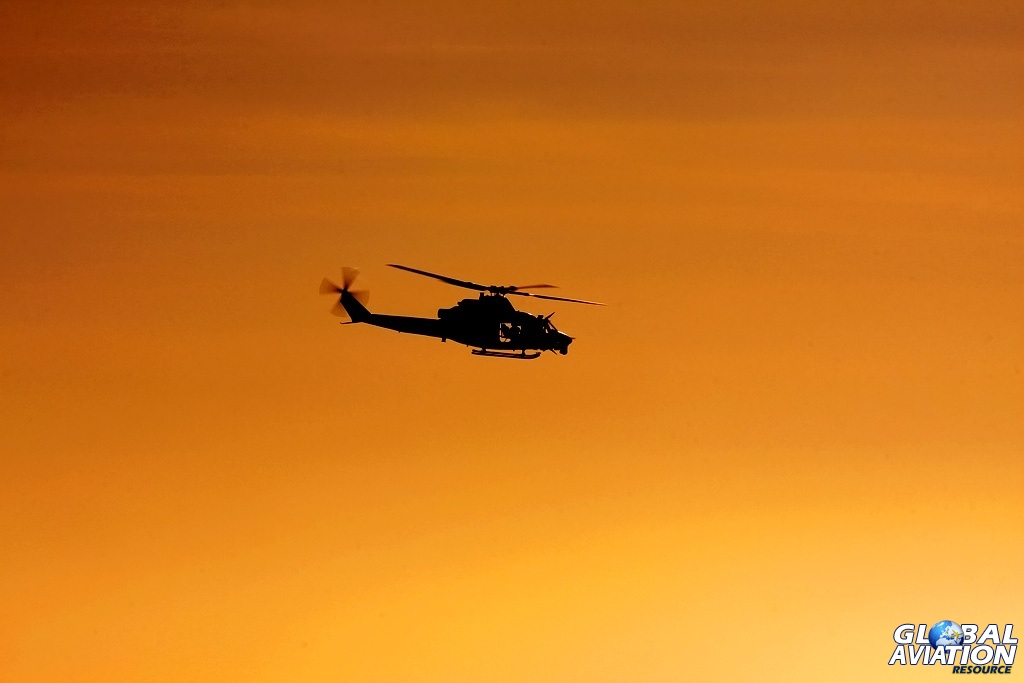
© Paul Dunn – www.globalaviationresource.com
The flow of information between pilot and crew chief is vital to the safe operation of the helicopter, especially given the potentially low level of experience of the crew as a whole, as Capt Morriss explains.
“The communication flow varies a lot with the mission and experience level. Here at 303 I would say we are telling them to tell us everything – how high are the skids, how high is the tail, come left, come right etc – to get the confidence level of the crew chiefs that are learning up and helping them learn to speak up, but also because the student pilot’s flight experience and level is not very good either, so they need that extra guidance to get to the right altitude for hovering etc.”
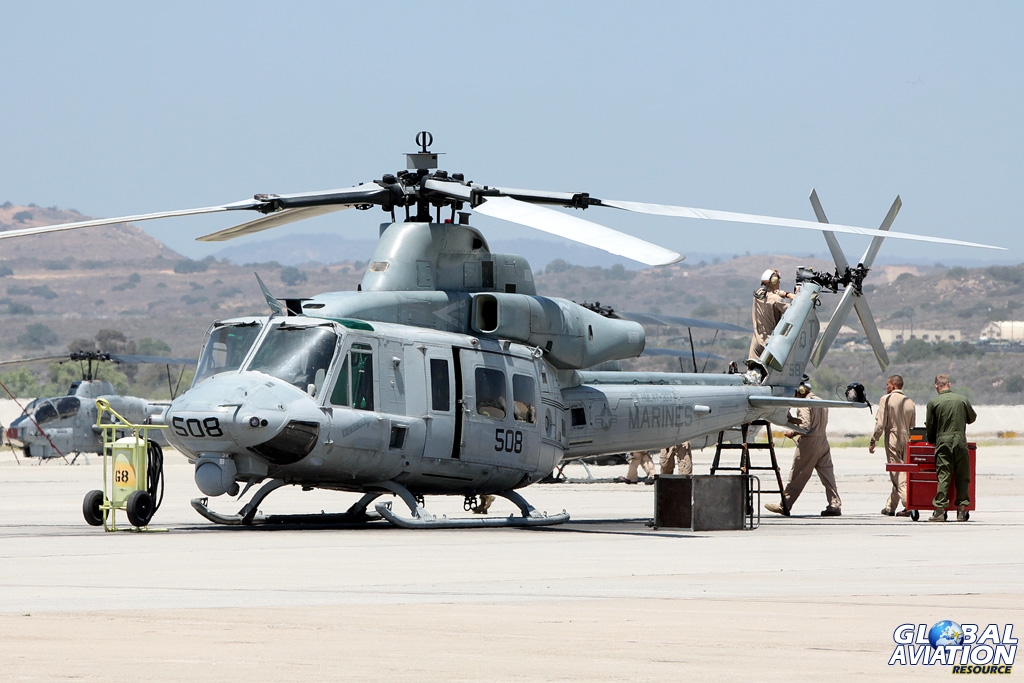
© Paul Dunn – www.globalaviationresource.com
From the point of view of the SSgt Francis, it can be a challenge to get his students to achieve the correct balance, a situation which can be further complicated by the difference in rank between the pilot and crew chief.
“That’s exactly what we teach the young crew chiefs, the importance of that flow of information from back to front and from front to back. Usually they’re not giving enough, it’s usually that guys are too timid and don’t want to speak up as much as they should.
“We try to get them to look past the rank difference, to realise that everybody’s in the aircraft and everybody is going to live or die! Getting them to see the big picture is definitely one of the obstacles we have to get past.”

HMLAT-303 no longer operates the UH-1N. This aircraft was with the squadron during 2011, when UH-1N training was still ongoing © Paul Dunn – www.globalaviationresource.com
The new helicopters that the HMLA squadrons operate represent a huge improvement in capability for the crews. With the UH-1Y having virtually usurped the UH-1N within the fleet squadrons and been proven in operations in Afghanistan, the Marine Corps now has a really effective multirole helicopter. Capt Morriss, having flown both the November and Yankee on operations is in a good position to comment on the improvements offered.
“The benefits of it are pretty obvious; a lot more power, a lot more speed, and a lot more capability. Whereas with the November we’d have to choose one mission to do, now we can do three or four missions at the same time, with everything we have on board. We can go out and deliver six marines or SEALs to the objective area and then have enough gas to remain there for an hour and a half, with ordnance to support them with close air support.”

A pair of UH-1Ys from HMLA-267 took part in the MAGTF demo at the 2012 Miramar Airshow. An MV-22B Osprey can be seen in the background © Paul Dunn – www.globalaviationresource.com
The Yankee is a machine which stands up well in comparison with other helicopters serving in a similar role in the US military and further afield.
“I would say, even though we’re light, our benchmark for the Huey is the UH-60. We have the same T700 engines (the Yankee, Whiskey and Zulu along with most versions of the UH-60 have the same engine), but the Huey is a little more manoeuvrable and more set up to be an attack platform than the ’60 is. We’re about 3,000lbs lighter on our basic weight, so it’s a bit smaller, but with the same amount of power. That means in certain regimes, such as hot and high, it tends to do a little better.”

© Paul Dunn – www.globalaviationresource.com
When it comes to discussing attack helicopters, there is one type that immediately springs to mind – the AH-64 Apache. Capt Armstrong believes that the AH-1Z is very much in the same league as the US Army’s formidable beast and shares the ability to deploy the latest Hellfire missiles.
“It’s a very similar capability – certainly the Zulu is more easily put against the Apache than the Whiskey because of the avionics upgrades.
“The generation of FLIR that we have on the Zulu matches the FLIR that’s on the Apache, but it’s a different style. The way that it integrates with the Apache fire control system is a little different than with the Zulu, because of some things that the Marine Corps didn’t purchase that the Army did, and vice versa, but the machine itself is amazing – with the upgraded technology, the aerodynamics, the capabilities that it can bring to the fight.”

© Paul Dunn – www.globalaviationresource.com
The AH-1 carries a crew of two and typically one crew member will act as the pilot and fly the aircraft, whereas the other will assume the role of mission commander. Both are qualified pilots, and all AH-1 pilots are trained to work in both seats should the need arise. The advent of the Zulu has given more flexibility to the crews and also caused a slight change in the way that they operate.
“We could always fly from both seats. Being a tandem layout, there’s controls in both seats for the Whiskey and the Zulu, but the Whiskey was a little more difficult to fly from the front seat as the controls there weren’t boosted controls. In the Zulu, both sets of controls are the same; now you have a small joystick for the cyclic and a shorter collective stick than a conventional style helicopter.

© Chris Wood – www.globalaviationresource.com
“Depending on the mission, the aircraft commander might choose to sit in the front or the back. With the Whiskey, whenever I ran a mission, I would sit in the front seat and have a peer of mine or someone just junior to me fly me around from the back seat, as it was easier to fly from the back. I would then set up my sensor suite in the front and run the mission.
“But now in the Zulu, we can do almost everything from both seats, so I would have the guy in the front flying as he’s got better visibility. That way I’d be in the back running everything; I can be more heads down, looking at maps, looking at the sensors, and the other guy can still see everything I’m doing as he can have the same pages up on the MFD.”

© Paul Dunn – www.globalaviationresource.com
The newer technology brings improved capabilities, but also new challenges, particularly in a training environment. For the crew chiefs, such as SSgt Francis, there is the added complication of dealing with the maintenance requirements of the new aircraft, which include far more ‘black boxes’ than the machines they replaced.
“The other side of it is that new technology gets more sophisticated. For the mechanics side of being a crew chief, it’s a lot harder to learn it and diagnose problems. The newer avionics portion of it is something we’re not really used to at this point; we’re still learning the ins and outs of it.”

© Paul Dunn – www.globalaviationresource.com
In flight, the amount of information available to the pilots also presents a challenge, especially when trying to teach brand new pilots, says Capt Morriss.
“Whereas before, you’d expect a new student to leave 303 knowing every single menu and submenu on the avionics package in the old Huey, now there’s just so much you can do with it tactically, it’s almost impossible for them to leave here with a good understanding of everything that you can do with the avionics. So it’s a much bigger hurdle to get over”
The key is to be selective about the information which a crew member chooses to assimilate, which is a key skill that needs to be taught, particularly to the RACs.

© Chris Wood – www.globalaviationresource.com
“For the younger guys it can be hard, learning what they need to know and what they don’t need to use. We try to help them as much as we can, telling them to ignore that now, you’ll get that later, so that they just focus on what’s important. It’s an awesome machine, once you learn it. It can make your life a lot easier with the automation and avionics, but it can also make it much harder at the early stages.”
This also applies to the AH-1Z as Capt Armstrong describes.
“The Whiskey Cobra has a very similar ‘legacy’ avionics package to the November, with some upgrades. You go to the Zulu and you’ve got identical avionics to the Yankee. From no moving map display to a full glass cockpit moving map display, everything is under glass. It wants to bring everything inside, you want to focus inside, so it’s tough to get the students, especially the younger pilots, to look outside and make them realise you need to fly the aircraft. It’s picking and choosing and dissecting that information and going with what you’ve got.”

In 2009, HMLA-267 operated the UH-1N and AH-1W; now the squadron has re-equipped with the ‘Yankee’ and ‘Zulu’ © Chris Wood – www.globalaviationresource.com
This commonality between types is a huge advantage to the Marines Corps. Although the UH-1N and AH-1W shared the same designation and had origins in original UH-1 family, the designs had diverged to such an extent that there was very little commonality between the November and the Whiskey, and only a tiny number of parts where interchangeable.
When design work for the replacement types was started, as they were developed alongside each other, a great deal of effort was made to make sure the Yankee and Zulu shared a large proportion of components and systems. In addition to the common avionics package, this includes sharing General Electric T700 engines, with an enhanced, four-bladed rotor system and common drive train system. The tail booms of both types are identical and it is reckoned that they share 84% of components.
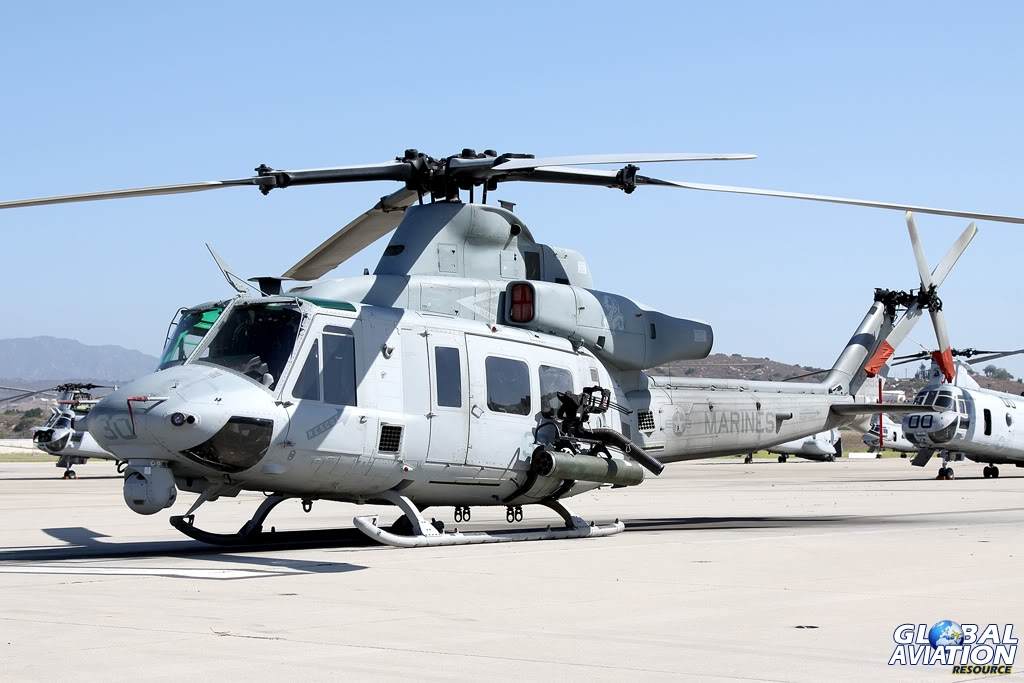
This UH-1Y carries the markings of HMM-268(REIN) ahead of a deployment with the 11th MEU © Paul Dunn – www.globalaviationresource.com
For maintainers such as SSgt Francis, it brings huge advantages and increased flexibility.
“With the November and the Whiskey, there wasn’t really anything on there that you could interchange, but now if you’ve got a bunch of Yankees that are up and Zulus that are down, then you can swap and utilise parts to get as many up aircraft as you can.”
Whilst on a day-to-day level this interchangeability has plenty of advantages, there are other, less obvious benefits. The concept of the Marine Air Ground Task Force (MAGTF) is key to the way the Marine Corps fights. This involves deployment of a suitable expeditionary force to fulfil a mission. As part of this concept, aviation units regularly deploy at sea as part of a Marine Expeditionary Unit (MEU).

In 2011, the UH-1Y and AH-1Z deployed together on a MEU for the first time © Paul Dunn – www.globalaviationresource.com
The Aviation Combat Element (ACE) of a MEU is formed from a reinforced HMM or VMM (Medium Helicopter or Medium Tiltrotor) unit operating either the CH-46, or more commonly these days, the MV-22B Osprey. The additional units assigned to the core squadron include tactical aircraft (AV-8B Harriers), heavy lift helicopters (CH-53E Super Stallion) and light attack helicopters. Each of these types requires logistic support and spare parts to be carried in the limited space available on the boat; the commonality between the UH-1Y and AH-1Z simplifies this process, according to Capt Morriss.
“Biggest benefit from a big picture standpoint is being able to have fewer parts on the boat with the MEU. From the big picture, Marine Corps version, that’s the biggest reason they wanted to push towards that, and it seems to help out a lot.”
The MEU is traditionally the USMC bread and butter operation, with amphibious assault being the trademark mission of the Corps as a whole. Of course, with all the US military being occupied with Operations Enduring Freedom and Iraqi Freedom over the last decade, there has been a decreased focus on that traditional role, but with the latter operation now over and the former well into a draw-down process, the future represents something of a return to business for the Marine Corps.

Normally assigned to HMLA-367, this AH-1Z was attached to HMM-268(REIN) for the first MEU deployment of the type © Paul Dunn – www.globalaviationresource.com
The HMLA units have been at the forefront of combat operations in Iraq and Afghanistan and will no doubt play a major role in future USMC deployments. The concept is something which works very well for the way that the Marine Corps operates and fights and Capt Morriss is keen to emphasise the unique spirit within the USMC as a whole.
“With the services, the way that Marine Aviation fights is very different from Army Aviation or indeed Naval Aviation. In the Marine Corps, all officers go to TBS (The Basic School) together, which is a six month infantry school, and all Marines go to bootcamp together, so all the crew chiefs have been to bootcamp with every infantry guy and they part ways then.
“In the officer corps, as it’s a much smaller community, I’d say that six times out of ten, the guy that you’re working with on the ground, you know him from somewhere, so there is a very personal relationship there. Because you’ve all gone to infantry school together, when you are out there supporting them from the air, you kind of already know what they’re doing and how they thinking. I think that tends to add a lot to our ability to support them.”

A ‘Whiskey’ pilot walks down the flightline at MCAS Camp Pendleton © Paul Dunn – www.globalaviationresource.com
Supporting Marines on the ground is the primary role of not only the HMLA squadrons but Marine Aviation as a whole. This shared background is vital to maintaining the spirit of the Marine Corps and also means that all Marines, regardless of their part in the jigsaw, speak the same language. Capt Armstrong agrees this is a vital aspect of their training.
“With all the different schools and training we attend, we may have our own branches but we all fall under the same umbrella, whether it’s close air support, assault support or what have you. We all know that everyone has been taught the same thing. So you know that if you hear a Marine jet in the overhead and you’re at medium altitude and you’ve got grunts on the ground or a convoy of armour, you know that we are all going to say the same things and they’ll mean the same things, for the most part. That means we can trust each other immediately, so that’s very helpful in an operational mindset.”

Colourful markings for the HMLAT-303 commander’s AH-1W © Paul Dunn – www.globalaviationresource.com
What sets the HMLA units apart is, of course, the incorporation of two separate weapons systems into the same squadron. The two different types have different roles, but they are complementary to each other, and the pairing is logical. That said, there are still differences in operational procedures and philosophy between the AH and UH pilots within the squadron, but there is a healthy dose of mutual respect too, as Capt Amstrong describes.
“The differences are something you have to accept. You’re going to work together and see each other every single day: you’re flying together, living with each other, deployed and on det, and it’s a really cool dynamic how you mesh together even though you are separate.”

© Rob Edgcumbe – www.globalaviationresource.com
That mutual respect extends, of course, to the crew chiefs in the squadron too; according to Capt Morriss, HMLA crew chiefs are a unique group of people within the Corps.
“The crew chiefs in the CH-46, CH-53 and C-130 communities are very different from the HMLA communities. We’re really the only community that has offensive fire power from our crew chief, so we expect them to attack offensively against a target and you don’t see that in any other community. It tends to breed a different mindset in the crew chiefs”

© Chris Wood – www.globalaviationresource.com
SSgt Francis agrees, highlighting the close bond between HMLA crews as a whole.
“You’ve pretty much hit the nail on the head there, even just going and working up before going overseas, you can definitely tell the difference, and not just in the crew chiefs and their mindsets, but also in the relationship with the pilots.”
The HMLA concept is a proven approach to providing support to Marines on the ground, with the UH-1N and AH-1W being proven designs which have given the Marine Corps sterling service over the years. In the UH-1Y/AH-1Z team, the US Marine Corps has a combination which is at least the equal of any similar one to be found throughout the world. Both helicopters are advanced machines and give the Corps flexibility and capability in today’s operational theatres, and the battlefields of the future.
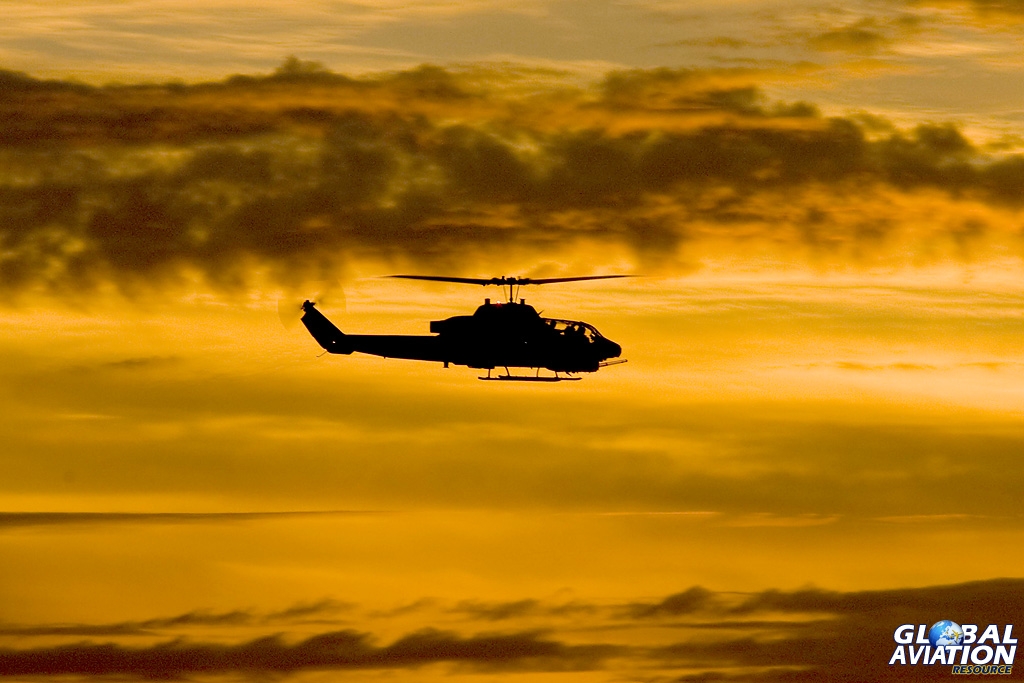
© Paul Dunn – www.globalaviationresource.com
The author would like to thank Maj Dean, Capt Armstrong, Capt Morriss and SSgt Francis from HMLAT-303 and 1st Lt Chad Hill from 3rd MAW Public Affairs for their assistance in preparing this article.


